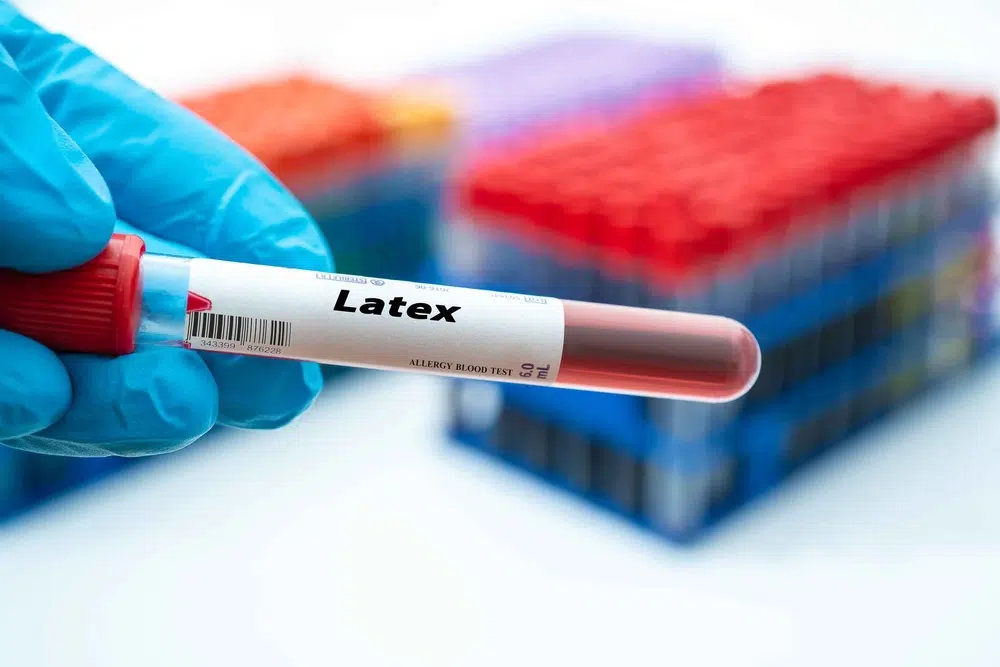
Latex Allergies Treatment
Latex allergy is a prevalent health concern that can cause mild to severe reactions in individuals who are sensitive to latex proteins. Penn Medicine Becker ENT & Allergy provides comprehensive latex allergy evaluation in New Jersey and Philadelphia to help adults and children manage their symptoms and minimize exposure to latex products.
- The Causes and Symptoms of a Latex Allergy
- Medical Considerations for Diagnosing a Latex Allergy
- Latex Allergic Reaction Treatment
- Steps to Take if You Think You Might Have a Latex Allergy
- Tips for Minimizing Exposure to Latex Products
- Preventing Cross-Reactivity
- Exploring Treatment Options for Severe Reactions
- Frequently Asked Questions about Latex Allergies
The Causes and Symptoms of a Latex Allergy
Latex is a natural rubber derived from the sap of Hevea brasiliensis, also known as the rubber tree. It is commonly used in various products such as gloves, balloons, condoms, and medical equipment. A latex allergy occurs when the immune system reacts to proteins found in natural rubber latex, causing an allergic reaction.
Symptoms of a latex allergy can range from mild to severe and may include:
- Skin redness, itching, rash, or hives
- Swelling of the lips, face, or tongue
- Runny nose, sneezing, coughing, wheezing, shortness of breath, and chest tightness
- Watery, itchy eyes
- Anaphylaxis: difficulty breathing, rapid heartbeat, low blood pressure, and loss of consciousness


Medical Considerations for Diagnosing a Latex Allergy
Medical professionals must consider the potential for a latex allergy when diagnosing a patient. Healthcare workers, particularly those in the rubber industry, and people with latex allergies are at an increased risk of developing an allergic reaction to latex. The most common reaction is allergic contact dermatitis, which causes an itchy rash on the skin upon contact with a latex product. A life-threatening allergic reaction known as anaphylaxis can occur after exposure to latex gloves and other medical supplies containing natural rubber products. This type of reaction includes severe respiratory symptoms, low blood pressure, and loss of consciousness. In milder cases, skin reactions such as hives or redness may be present after coming into contact with surgical or medical gloves containing latex. In order to properly diagnose a latex allergy, healthcare providers may perform skin prick tests or draw blood to measure for IgE antibodies specific to the allergen involved in your reaction. With proper medical treatment and education about avoiding latex exposures, individuals with a sensitivity to natural rubber can manage their condition successfully and reduce their risk of serious complications from their allergy.
Latex Allergic Reaction Treatment
The treatment for latex allergies is determined by the severity of the individual’s reaction. At Penn Medicine Becker ENT & Allergy, we provide comprehensive care for allergy management.
Skin Prick Tests for Latex Allergy Diagnosis
To confirm a latex allergy diagnosis, an allergy specialist may conduct a skin prick test. This diagnostic procedure involves applying a trace amount of latex protein to the patient’s skin. Following that, the patient is closely monitored for any adverse reactions or signs of an allergic reaction.
Medication Treatments for Severe Reactions to Latex
If accidental contact with latex occurs, medications such as antihistamines or corticosteroids may be prescribed to control the allergic reaction and alleviate discomfort. In cases of severe allergic reactions, individuals may need to carry injectable epinephrine and seek emergency medical attention immediately.
Immunotherapy as a Treatment for Latex Allergy
Immunotherapy, commonly known as allergy shots, may be an appropriate treatment option for some individuals diagnosed with latex allergies. This long-term method of treatment involves the gradual introduction of small doses of latex protein into the patient’s system through a series of injections. Over time, these injections help the immune system become desensitized to the allergen, reducing the severity of allergic reactions and potentially providing relief from latex allergy symptoms.
Avoidance of Latex Products to Reduce Exposure and Symptoms
One of the most effective strategies for managing a latex allergy is to minimize contact with latex-containing products. This may involve using alternative materials such as vinyl or nitrile gloves and synthetic rubber products. Avoidance may be especially hard for children because they may not always be able to identify which products contain latex.
Oxygen Therapy and Anaphylaxis Treatments for Latex Allergies
In the event of a severe reaction, such as anaphylaxis, prompt treatment is critical. Emergency department care for anaphylaxis normally includes intravenous medications, fluids, and oxygen therapy to relieve breathing symptoms and prevent other complications. Anaphylaxis is a life-threatening condition that requires immediate medical intervention to ensure the best possible outcome for the affected individual.
Steps to Take if You Think You Might Have a Latex Allergy
If you suspect that you have a latex allergy, it is essential to consult with an allergist for proper diagnosis and latex allergy treatment. In the meantime, it is important to educate yourself on which products contain latex and avoid exposure to them, as repeated exposure to an allergen could lead to more severe reactions.
Treat the suspicion as if it were already confirmed, including informing your doctors so that they can take precautions to avoid a reaction.
Schedule your consultation
Tips for Minimizing Exposure to Latex Products
The best way to minimize exposure to latex products is to understand which materials contain latex and avoid contact with them. Latex is a natural rubber material derived from the sap of the rubber tree plant, and can be found in many everyday products such as rubber toys, balloons, and gloves. Those at higher risk of developing a latex allergy include individuals with a history of food allergies, a medical history of asthma or eczema, or those who have been exposed to passion fruit.
Another latex allergy tip for those who come into direct contact with these types of products is that wearing non-latex gloves can help reduce exposure. Individuals should be aware that even short periods of skin exposure (less than 10 minutes) could still lead to an allergic reaction or irritant contact dermatitis. People should also avoid exposure to mucous membranes when using latex materials as these areas are particularly vulnerable to anaphylactic reactions. It is also important for people diagnosed with a latex allergy to inform their healthcare providers so that they can take appropriate precautions during medical procedures or examinations.
Preventing Cross-Reactivity
Preventing cross-reactivity is an important part of managing latex allergies and other allergies. Cross-reactivity occurs when people are allergic to one substance, such as latex, and then develop an allergic reaction to another related substance. It is important for those with a known or suspected latex allergy to receive appropriate medical care from an allergist/immunologist. Allergy skin tests and blood tests can help diagnose the underlying cause of the symptoms and determine which substances may cause a reaction in sensitive individuals.
Latex allergy and food cross-reactivity can occur with a wide range of substances such as fruits including bananas, avocados, and passion fruit; certain nuts like chestnuts; vegetables such as potatoes; proteins found in milk products; meat from animals like pork; wheat germ; dust mites; pollens; certain medications including antibiotics like penicillin; rubber chemicals used in manufacturing processes, etc.

Certain occupations such as healthcare workers who are exposed to large amounts of latex gloves have a higher risk of developing sensitization against latex proteins due to frequent exposure over long periods of time. It is therefore important for individuals with known or suspected allergies to latex materials to take preventive measures and avoid contact with these materials whenever possible in order to minimize exposure and reduce the risk of developing cross-reactive allergies.
Exploring Treatment Options for Severe Reactions
In addition to the treatments mentioned earlier, other options are available for managing severe reactions to latex. These include:
Home Remedies and Natural Treatments for Latex Allergies
For those with a known latex allergy or family history of allergies, some home remedies a may help reduce the risk of reaction. These include using alternative products such as synthetic rubber materials instead of latex whenever possible, and avoiding contact with items that contain natural rubber proteins (such as balloons, rubber toys, or medical gloves). In addition, it is essential to always carry an epinephrine auto-injector in case of an extreme allergic reaction.
Anti-Histamines as a Treatment for Latex Allergy Symptoms
Antihistamines are a standard treatment for latex allergy symptoms. Antihistamines block the action of histamine, a chemical released by the body in response to an allergen. They can help relieve some of the symptoms associated with a latex allergy including sneezing, itching, hives, and nasal congestion. It is important to speak with an allergist or healthcare provider before taking any medications as they will be able to recommend the most appropriate treatment plan based on individual needs and medical history.
Diet Modification to Help Alleviate Symptoms of Latex Allergy
For those with a latex allergy, dietary modifications may help alleviate symptoms. It is essential to avoid certain foods that contain proteins similar to those found in latex such as bananas, avocados, chestnuts, and wheat germ. Additionally, it is recommended to limit or avoid exposure to other substances that can cause cross-reactivity including dairy products, pork, dust mites, pollens, and antibiotics such as penicillin. A healthcare professional or allergist can provide guidance on the best dietary approach for individuals with a known latex allergy.

Pick one of our convenient locations
for your Latex Allergy Treatment
